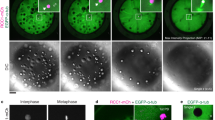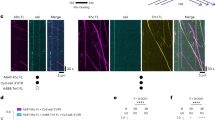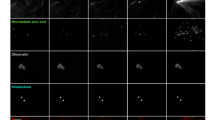Abstract
Microtubules and the plus-end-directed microtubule motor Kinesin I are required for the selective accumulation of oskar mRNA at the posterior cortex of the Drosophila melanogaster oocyte, which is essential to posterior patterning and pole plasm assembly. We present evidence that microtubule minus ends associate with the entire cortex, and that Kinesin and microtubules are not required for oskar mRNA association with the posterior pole, but prevent ectopic localization of this transcript and the pole plasm proteins Oskar and Vasa to other cortical regions. Cortical binding of oskar mRNA seems to be dependent on the actin cytoskeleton. We conclude that most of the actin-rich oocyte cortex can support pole plasm assembly, and propose that Kinesin restricts pole plasm formation to the posterior by moving oskar mRNA away from microtubule-rich lateral and anterior cortical regions.
This is a preview of subscription content, access via your institution
Access options
Subscribe to this journal
Receive 12 print issues and online access
$209.00 per year
only $17.42 per issue
Buy this article
- Purchase on Springer Link
- Instant access to full article PDF
Prices may be subject to local taxes which are calculated during checkout







Similar content being viewed by others
References
van Eeden, F. & St Johnston, D. The polarisation of the anterior–posterior and dorsal–ventral axes during Drosophila oogenesis. Curr. Opin. Genet. Dev. 9, 396–404 (1999).
Riechmann, V. & Ephrussi, A. Axis formation during Drosophila oogenesis. Curr. Opin. Genet. Dev. 11, 374–383 (2001).
Driever, W., Siegel, V. & Nüsslein-Volhard, C. Autonomous determination of anterior structures in the early Drosophila embryo by the bicoid morphogen. Development 109, 811–820 (1990).
Kim-Ha, J., Smith, J. L. & Macdonald, P. M. oskar mRNA is localized to the posterior pole of the Drosophila oocyte. Cell 66, 23–35 (1991).
Ephrussi, A., Dickinson, L. K. & Lehmann, R. Oskar organizes the germ plasm and directs localization of the posterior determinant nanos. Cell 66, 37–50 (1991).
St Johnston, D., Beuchle, D. & Nüsslein-Volhard, C. Staufen, a gene required to localize maternal RNAs in the Drosophila egg. Cell 66, 51–63 (1991).
Hay, B., Jan, L. Y. & Jan, Y. N. Localization of vasa, a component of Drosophila polar granules, in maternal-effect mutants that alter embryonic anteroposterior polarity. Development 109, 425–433 (1990).
Neuman-Silberberg, F. S. & Schüpbach, T. The Drosophila dorsoventral patterning gene gurken produces a dorsally localized RNA and encodes a TGFα-like protein. Cell 75, 165–174 (1993).
Gonzalez-Reyes, A., Elliott, H. & St Johnston, D. Polarization of both major body axes in Drosophila by gurken-torpedo signalling. Nature 375, 654–658 (1995).
Grunert, S. & St Johnston, D. RNA localization and the development of asymmetry during Drosophila oogenesis. Curr. Opin. Genet. Dev. 6, 395–402 (1996).
Hays, T. & Karess, R. Swallowing dynein: a missing link in RNA localization? Nature Cell Biol. 2, E60–E62 (2000).
Theurkauf, W. E. Microtubules and cytoplasm organization during Drosophila oogenesis. Dev. Biol. 165, 352–360 (1994).
Pokrywka, N. J. & Stephenson, E. C. Microtubules mediate the localization of bicoid RNA during Drosophila oogenesis. Development 113, 55–66 (1991).
Pokrywka, N. J. & Stephenson, E. C. Microtubules are a general component of mRNA localization systems in Drosophila oocytes. Dev. Biol. 167, 363–370 (1995).
Clark, I., Giniger, E., Ruohola-Baker, H., Jan, L. Y. & Jan, Y. N. Transient posterior localization of a kinesin fusion protein reflects anteroposterior polarity of the Drosophila oocyte. Curr. Biol. 4, 289–300 (1994).
Brendza, R. P., Serbus, L. R., Duffy, J. B. & Saxton, W. M. A function for kinesin I in the posterior transport of oskar mRNA and Staufen protein. Science 289, 2120–2122 (2000).
Lane, M. E. & Kalderon, D. RNA localization along the anteroposterior axis of the Drosophila oocyte requires PKA-mediated signal transduction to direct normal microtubule organization. Genes Dev. 8, 2986–2995 (1994).
Micklem, D. R. et al. The mago nashi gene is required for the polarisation of the oocyte and the formation of perpendicular axes in Drosophila. Curr. Biol. 7, 468–478 (1997).
Emmons, S. et al. Cappuccino, a Drosophila maternal effect gene required for polarity of the egg and embryo, is related to the vertebrate limb deformity locus. Genes Dev. 9, 2482–2494 (1995).
Manseau, L. J. & Schüpbach, T. cappuccino and spire: two unique maternal-effect loci required for both the anteroposterior and dorsoventral patterns of the Drosophila embryo. Genes Dev. 3, 1437–1452 (1989).
Glotzer, J. B., Saffrich, R., Glotzer, M. & Ephrussi, A. Cytoplasmic flows localize injected oskar RNA in Drosophila oocytes. Curr. Biol. 7, 326–337 (1997).
Li, M., McGrail, M., Serr, M. & Hays, T. S. Drosophila cytoplasmic dynein, a microtubule motor that is asymmetrically localized in the oocyte. J. Cell Biol. 126, 1475–1494 (1994).
Theurkauf, W. E., Smiley, S., Wong, M. L. & Alberts, B. M. Reorganization of the cytoskeleton during Drosophila oogenesis: implications for axis specification and intercellular transport. Development 115, 923–936 (1992).
Cha, B. J., Koppetsch, B. S. & Theurkauf, W. E. In vivo analysis of Drosophila bicoid mRNA localization reveals a novel microtubule-dependent axis specification pathway. Cell 106, 35–46 (2001).
Zheng, Y., Wong, M. L., Alberts, B. & Mitchison, T. Nucleation of microtubule assembly by a γ-tubulin-containing ring complex. Nature 378, 578–583 (1995).
Moritz, M., Braunfeld, M. B., Guenebaut, V., Heuser, J. & Agard, D. A. Structure of the γ-tubulin ring complex: a template for microtubule nucleation. Nature Cell Biol. 2, 365–370 (2000).
Clegg, N. J. et al. maelstrom is required for an early step in the establishment of Drosophila oocyte polarity: posterior localization of grk mRNA. Development 124, 4661–4671 (1997).
Lin, H. & Spradling, A. C. Germline stem cell division and egg chamber development in transplanted Drosophila germaria. Dev. Biol. 159, 140–152 (1993).
Karlin-Mcginness, M., Serano, T. L. & Cohen, R. S. Comparative analysis of the kinetics and dynamics of K10, bicoid, and oskar mRNA localization in the Drosophila oocyte. Dev. Genet. 19, 238–248 (1996).
Vale, R. D., Reese, T. S. & Sheetz, M. P. Identification of a novel force-generating protein, kinesin, involved in microtubule-based motility. Cell 42, 39–50 (1985).
Gunawardane, R. N. et al. Characterization and reconstitution of Drosophila γ-tubulin ring complex subunits. J. Cell Biol. 151, 1513–1524 (2000).
Megraw, T. L., Li, K., Kao, L. R. & Kaufman, T. C. The centrosomin protein is required for centrosome assembly and function during cleavage in Drosophila. Development 126, 2829–2839 (1999).
Erdelyi, M., Michon, A. M., Guichet, A., Glotzer, J. B. & Ephrussi, A. Requirement for Drosophila cytoplasmic tropomyosin in oskar mRNA localization. Nature 377, 524–527 (1995).
Manseau, L., Calley, J. & Phan, H. Profilin is required for posterior patterning of the Drosophila oocyte. Development 122, 2109–2116 (1996).
Markussen, F. H., Michon, A. M., Breitwieser, W. & Ephrussi, A. Translational control of oskar generates short OSK, the isoform that induces pole plasma assembly. Development 121, 3723–3732 (1995).
Rongo, C., Gavis, E. R. & Lehmann, R. Localization of oskar RNA regulates oskar translation and requires Oskar protein. Development 121, 2737–2746 (1995).
Ephrussi, A. & Lehmann, R. Induction of germ cell formation by oskar. Nature 358, 387–392 (1992).
Dollar, G., Struckhoff, E., Michaud, J. & Cohen, R. S. Rab11 polarization of the Drosophila oocyte: a novel link between membrane trafficking, microtubule organization, and oskar mRNA localization and translation. Development 129, 517–526 (2002).
Roth, S., Neuman-Silberberg, F. S., Barcelo, G. & Schüpbach, T. cornichon and the EGF receptor signaling process are necessary for both anterior–posterior and dorsal–ventral pattern formation in Drosophila. Cell 81, 967–978 (1995).
Shulman, J. M., Benton, R. & St Johnston, D. The Drosophila homolog of C. elegans PAR-1 organizes the oocyte cytoskeleton and directs oskar mRNA localization to the posterior pole. Cell 101, 377–388 (2000).
Tomancak, P. et al. A Drosophila melanogaster homologue of Caenorhabditis elegans par-1 acts at an early step in embryonic-axis formation. Nature Cell Biol. 2, 458–460 (2000).
Drewes, G., Ebneth, A., Preuss, U., Mandelkow, E. M. & Mandelkow, E. MARK, a novel family of protein kinases that phosphorylate microtubule-associated proteins and trigger microtubule disruption. Cell 89, 297–308 (1997).
Chou, T. B., Noll, E. & Perrimon, N. Autosomal P[ovoD1] dominant female-sterile insertions in Drosophila and their use in generating germ-line chimeras. Development 119, 1359–1369 (1993).
Theurkauf, W. E. Immunofluorescence analysis of the cytoskeleton during oogenesis and early embryogenesis. Methods Cell Biol. 44, 489–505 (1994).
Tautz, D. & Pfeifle, C. A non-radioactive in situ hybridization method for the localization of specific RNAs in Drosophila embryos reveals translational control of the segmentation gene hunchback. Chromosoma 98, 81–85 (1989).
Acknowledgements
Special thanks to Y. Zheng, A. Ephrussi, P. Lasko, E. Schejter, and T. Kaufman for antibodies used in this study. We also thank members of the Theurkauf lab and B. Saxton for comments on the manuscript. This work was supported by a Research Scholar Grant RGS CSM-101560 from the American Cancer Society awarded to W.E.T.
Author information
Authors and Affiliations
Corresponding author
Ethics declarations
Competing interests
The authors declare no competing financial interests.
Rights and permissions
About this article
Cite this article
Cha, BJ., Serbus, L., Koppetsch, B. et al. Kinesin I-dependent cortical exclusion restricts pole plasm to the oocyte posterior. Nat Cell Biol 4, 592–598 (2002). https://doi.org/10.1038/ncb832
Received:
Revised:
Accepted:
Published:
Issue Date:
DOI: https://doi.org/10.1038/ncb832
This article is cited by
-
JAK-STAT-dependent contact between follicle cells and the oocyte controls Drosophila anterior-posterior polarity and germline development
Nature Communications (2024)
-
Subcellular spatial transcriptomics identifies three mechanistically different classes of localizing RNAs
Nature Communications (2022)
-
Control of RNP motility and localization by a splicing-dependent structure in oskar mRNA
Nature Structural & Molecular Biology (2012)
-
Spindle assembly in the oocytes of mouse and Drosophila – similar solutions to a problem
Chromosome Research (2007)
-
Coordination of microtubule and microfilament dynamics by Drosophila Rho1, Spire and Cappuccino
Nature Cell Biology (2006)



